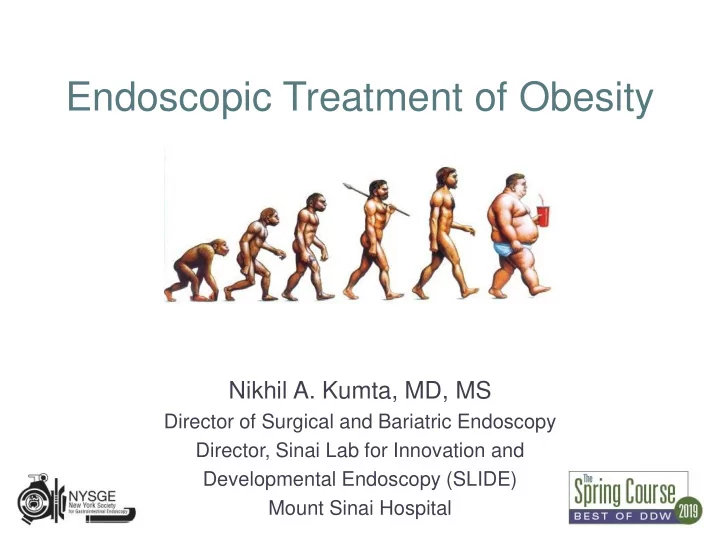

Endoscopic Treatment of Obesity Nikhil A. Kumta, MD, MS Director of Surgical and Bariatric Endoscopy Director, Sinai Lab for Innovation and Developmental Endoscopy (SLIDE) Mount Sinai Hospital
Disclosures • Consultant: Apollo Endosurgery, Boston Scientific, Olympus
Introduction to the Obesity Epidemic • Obesity is a metabolic disease with severe toll of co-morbid illness • Prevalence is rising: 15% in 1980, 36% in 2010 • Estimated 32 million more people will be obese in 2030 (42% of US population) – Severe obesity (> 100 pounds overweight) expected to double (11% of US population) • Costs – Obesity accounts for at least 9% of health spending -> $150 billion – Incremental cost of $1,429/obese person Flegal KM et al, JAMA, 2012 Cawley J, J Health Econ, 2012 3 CDC, “Weight of the Nation”, 2012
Adams KF, et al. NEJM 2006; 355: 763-778.
Targeted Endoscopic Therapy • Stomach – Space occupying devices – Gastric plication – Aspiration • Small Bowel Stronger Obesity Antidiabetic - Sleeves Effect - Duodenal resurfacing - Anastomosis - Flow altering
TransPyloric Shuttle • Large spherical bulb filled with a coiled cord of silicone attached via flexible tether to a smaller distal bulb • Endoscopic delivery and removal (1 year), outpatient procedure • Mechanism involves delay in gastric emptying • FDA approved April 2019: BMI 35-40 or BMI 30-35 with an obesity related co-morbidity Video ENDObesity II study. Obesity Week 2018.
Methods • 302 patients across 9 centers with 2:1 randomization, sham-controlled, double-blind • BMI 30-34.9 with comorbidity or BMI 35-40 • Endoscopy study team was separate and isolated from study coordinator team that followed the subjects
Outcomes • Mean %TBWL between TPS and control at 1 year • % of TPS subjects with >5% TBWL at 1 year
Results
Responder Rates
BMI changes from baseline
Significant change in BP in TPS group
Improved in lipid profile in patients with baseline hyperlipidemia
Factors associated with cardiometabolic improvement • Treatment with TPS resulted in cardiometabolic improvement through weight loss • Extent of improvement correlates with magnitude of weight loss • Baseline values and age were confounders: – The higher the baseline, the more improvement in BP and lipid parameters – Younger age was associated with greater improvement in lipid parameters
Serious Adverse Events • Device and procedure-related TPS SAE – 2.8% • All SAEs resolved • For comparison: fluid-filled balloon SAE 7.5-10%, gas-filled balloon SAE 0.3%
DDW Conclusion • TPS: 9.5% TBWL vs 2.8% control at 12 months • At 1 year, ~67% of TPS patients achieved >5% TBWL and ~40% achieved >10% TBWL • TPS group with significantly greater improvement in cardiometabolic risk factors • SAE rate 2.8%
Space Occupying Balloons
FDA Approved Space Occupying Balloons 20
Spatz Adjustable Intragastric Balloon Machytka E et al, Obes Surg, 2011 Genco A et al, Obes Surg, 2013 Brooks J et al, Obes Surg, 2014
Methods • 288 patients across 7 centers • Open-label RCT of adjustable IGB plus lifestyle therapy vs lifestyle therapy alone
Adjustment Algorithm
%TBWL between groups
Downward adjustment of IGB • 52 patients with intolerance – 24 IGB explanted – 28 down adjusted
Upward adjustment of IGB
Serious adverse events – 3.7%
Comparison to other space occupying devices
DDW Conclusion • Adjustable IGB system results in significant weight loss and maintenance compared to lifestyle alone • Good safety profile • Adjustability feature: maximize tolerance and manage weight loss plateaus • Results submitted to FDA for approval
Endoscopic Sleeve Gastroplasty (ESG) • Incisionless, minimally invasive technique via endoscopic approach • Utilizes full thickness sutures
Aims • To evaluate the durability of weight loss up to 5 years after ESG – Predictors of long term weight loss – Characterize average weight loss trajectory after ESG – Assessment of procedural adverse events
Methods • Retrospective single center analysis • 203 patients who underwent ESG between Aug 2013 and Oct 2018 – Body Mass Index (BMI) > 30 kg/m 2 – Failed noninvasive weight loss measures – Non-surgical candidates or refused surgery • Primary outcome: %TBWL
Baseline Characteristics
Baseline BMI distribution
Maximum weight loss: 24 months
Early post-ESG weight loss predicts long term outcomes
Follow-up rates after ESG
Adverse Events • Serious adverse events: < 1% – Peri-gastric fluid collection – Gastric perforation managed with OTSC
Limitations • Lack of sham-controlled randomization • Generalizability of findings • Use of concurrent medications for weight loss (~25%) • Lack of insurance coverage
DDW Conclusion • 5 year retrospective ESG study: – Long term durable weight loss: 14.5% TBWL – Maximum weight loss achieved at 24 months – Safe with SAE < 1% – Failure to achieve significant weight loss (>10% TBWL) within 3 months post-ESG • Ongoing prospective RCT comparing ESG + diet/lifestyle vs diet/lifestyle alone
Thank-you • Nikhil.Kumta@mountsinai.org
Recommend
More recommend